Opinion & Analysis
The myth behind the “one-way miss”
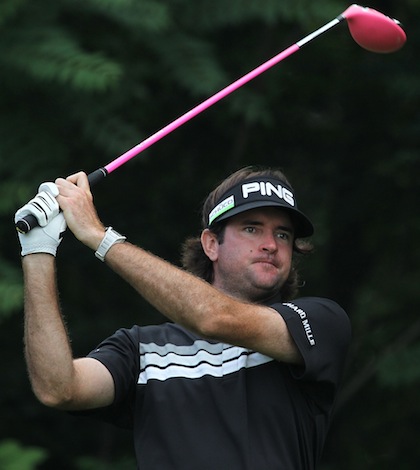
We often hear from professional golfers how important it is to have a “one way miss’”and to be able to “take one side of the golf course out of play” in order to drive the ball more effectively. However, statistical evidence indicates that this is not quite an accurate depiction of how the best golfers in the world effectively drive the ball.
A metric that I have explored quite frequently is “miss bias.” This is the percentage of time a player misses a fairway right or left. What I have found is that there is no direction that is better to miss the fairway. Having a right miss bias is equal to having a left miss bias. Typically, what is more important is the ratio of the miss bias.
I feel the best indicator of driving success is to look at the top players in my “Driving Effectiveness” ranking. Driving Effectiveness is based on algorithm that considers the following metrics:
- Driving distance
- Fairway percentage
- Average distance from the edge of fairway (on drives that miss the fairway)
- Percentage of fairway bunkers hit
- Missed fairways and other (shots that end up in the trees, water, O.B, etc.)
Here is a table with the current top-20 players in Driving Effectiveness and their Miss Bias.
As the chart shows, 13 of the top-20 ranked players have a miss bias that is no more than 55 percent either way.
Now, let’s look at this year’s players with miss biases that are greater than 60 percent and their rankings in Driving Effectiveness.
Tour golfers can strike the ball well off the tee with a large miss bias, however, not one of these players on the list is ranked in the top 20 in Driving Effectiveness. Furthermore, let’s take a look at the players on that list that played last on the Tour last season.
The chart shows that if the player’s miss bias in 2012 was less than 60 percent, they were typically more effective off the tee. Rod Pampling, Rory McIlroy, John Huh and Tiger Woods are examples of golfers that had a miss bias less than 60 percent in 2012 and also drove the ball much more effectively as well.
What the data tells me is that trying to taking one side “out of play” is not great advice if you wish to be an effective driver of the ball. There are likely too many holes where the golfer has to favor the right side or the left side.
What I’ve seen from my tour players is that having a “one-way miss” is actually more about having a “one-way curve.” If a golfer tend to hit a draw with their stock swing, they’ll be best served to continue to hit draws or straight balls off the tee. When many golfers try to alternate between draws and fades, however, they often risk getting into trouble and being less effective off the tee.
If a player has a more extreme miss bias, that tends to indicate a common “big miss” that they cannot rid themselves of. And that miss may cost them down the line.
I recommend that amateur golfers forget about having a “one-way miss.” They need to concern themselves with getting the ball to curve one way, and identify that common “big miss” and work to make it a smaller one.
- LIKE7
- LEGIT1
- WOW0
- LOL0
- IDHT1
- FLOP1
- OB2
- SHANK0
Opinion & Analysis
The Wedge Guy: What really makes a wedge work? Part 1

Of all the clubs in our bags, wedges are almost always the simplest in construction and, therefore, the easiest to analyze what might make one work differently from another if you know what to look for.
Wedges are a lot less mysterious than drivers, of course, as the major brands are working with a lot of “pixie dust” inside these modern marvels. That’s carrying over more to irons now, with so many new models featuring internal multi-material technologies, and almost all of them having a “badge” or insert in the back to allow more complex graphics while hiding the actual distribution of mass.
But when it comes to wedges, most on the market today are still single pieces of molded steel, either cast or forged into that shape. So, if you look closely at where the mass is distributed, it’s pretty clear how that wedge is going to perform.
To start, because of their wider soles, the majority of the mass of almost any wedge is along the bottom third of the clubhead. So, the best wedge shots are always those hit between the 2nd and 5th grooves so that more mass is directly behind that impact. Elite tour professionals practice incessantly to learn to do that consistently, wearing out a spot about the size of a penny right there. If impact moves higher than that, the face is dramatically thinner, so smash factor is compromised significantly, which reduces the overall distance the ball will fly.
Every one of us, tour players included, knows that maddening shot that we feel a bit high on the face and it doesn’t go anywhere, it’s not your fault.
If your wedges show a wear pattern the size of a silver dollar, and centered above the 3rd or 4th groove, you are not getting anywhere near the same performance from shot to shot. Robot testing proves impact even two to three grooves higher in the face can cause distance loss of up to 35 to 55 feet with modern ‘tour design’ wedges.
In addition, as impact moves above the center of mass, the golf club principle of gear effect causes the ball to fly higher with less spin. Think of modern drivers for a minute. The “holy grail” of driving is high launch and low spin, and the driver engineers are pulling out all stops to get the mass as low in the clubhead as possible to optimize this combination.
Where is all the mass in your wedges? Low. So, disregarding the higher lofts, wedges “want” to launch the ball high with low spin – exactly the opposite of what good wedge play requires penetrating ball flight with high spin.
While almost all major brand wedges have begun putting a tiny bit more thickness in the top portion of the clubhead, conventional and modern ‘tour design’ wedges perform pretty much like they always have. Elite players learn to hit those crisp, spinny penetrating wedge shots by spending lots of practice time learning to consistently make contact low in the face.
So, what about grooves and face texture?
Grooves on any club can only do so much, and no one has any material advantage here. The USGA tightly defines what we manufacturers can do with grooves and face texture, and modern manufacturing techniques allow all of us to push those limits ever closer. And we all do. End of story.
Then there’s the topic of bounce and grinds, the most complex and confusing part of the wedge formula. Many top brands offer a complex array of sole configurations, all of them admittedly specialized to a particular kind of lie or turf conditions, and/or a particular divot pattern.
But if you don’t play the same turf all the time, and make the same size divot on every swing, how would you ever figure this out?
The only way is to take any wedge you are considering and play it a few rounds, hitting all the shots you face and observing the results. There’s simply no other way.
So, hopefully this will inspire a lively conversation in our comments section, and I’ll chime in to answer any questions you might have.
And next week, I’ll dive into the rest of the wedge formula. Yes, shafts, grips and specifications are essential, too.
- LIKE22
- LEGIT6
- WOW1
- LOL1
- IDHT2
- FLOP2
- OB1
- SHANK1
Golf's Perfect Imperfections
Golf’s Perfect Imperfections: Amazing Session with Performance Coach Savannah Meyer-Clement

In this week’s episode, we spent some time with performance coach Savannah Meyer-Clement who provides many useful insights that you’ll be able to implement on the golf course.
- LIKE0
- LEGIT0
- WOW0
- LOL0
- IDHT0
- FLOP0
- OB0
- SHANK0
19th Hole
Vincenzi’s 2024 RBC Heritage betting preview: Patrick Cantlay ready to get back inside winner’s circle

Just a two-hour drive from Augusta National, the PGA TOUR heads to Harbour Town Golf Links in Hilton Head Island, S.C. Hilton Head Island is a golfer’s paradise and Harbour Town is one of the most beautiful and scenic courses on the PGA TOUR.
Harbour Town Golf Links is a par-71 that measures 7,121 yards and features Bermuda grass greens. A Pete Dye design, the course is heavily tree lined and features small greens and many dog legs, protecting it from “bomb-and-gauge” type golfers.
The field is loaded this week with 69 golfers with no cut. Last year was quite possibly the best field in RBC Heritage history and the event this week is yet another designated event, meaning there is a $20 million prize pool.
Most of the big names on the PGA Tour will be in attendance this week with the exceptions of Hideki Matsuyama and Viktor Hovland. Additionally, Webb Simpson, Shane Lowry, Gary Woodland and Kevin Kisner have been granted sponsors exemptions.
Past Winners at Harbour Town
- 2023: Matt Fitzpatrick (-17)
- 2022: Jordan Spieth (-13)
- 2021: Stewart Cink (-19)
- 2020: Webb Simpson (-22)
- 2019: CT Pan (-12)
- 2018: Sotoshi Kodaira (-12)
- 2017: Wesley Bryan (-13)
- 2016: Branden Grace (-9)
- 2015: Jim Furyk (-18)
In this article and going forward, I’ll be using the Rabbit Hole by Betsperts Golf data engine to develop my custom model. If you want to build your own model or check out all of the detailed stats, you can sign up using promo code: MATTVIN for 25% off any subscription package (yearly is best value).
Key Stats For Harbour Town
Let’s take a look at key metrics for Harbour Town Golf Links to determine which golfers boast top marks in each category over their past 24 rounds.
Strokes Gained: Approach
Strokes Gained: Approach is exceedingly important this week. The greens at Harbour Town are about half the size of PGA TOUR average and feature the second-smallest greens on the tour. Typical of a Pete Dye design, golfers will pay the price for missed greens.
Total SG: Approach Over Past 24 Rounds
- Scottie Scheffler (+1.27)
- Tom Hoge (+1.27)
- Corey Conners (+1.16)
- Austin Eckroat (+0.95)
- Cameron Young (+0.93)
Good Drive %
The fairways at Harbour Town are tree lined and feature many dog legs. Bombers tend to struggle at the course because it forces layups and doesn’t allow long drivers to overpower it. Accuracy is far more important than power.
Good Drive % Over Past 24 Rounds
- Brice Garnett (88.8%)
- Shane Lowry (+87.2%)
- Akshay Bhatia (+86.0%)
- Si Woo Kim (+85.8%)
- Sepp Straka (+85.1%)
Strokes Gained: Total at Pete Dye Designs
Pete Dye specialists tend to play very well at Harbour Town. Si Woo Kim, Matt Kuchar, Jim Furyk and Webb Simpson are all Pete Dye specialists who have had great success here. It is likely we see some more specialists near the top of the leaderboard this week.
SG: TOT Pete Dye per round over past 36 rounds:
- Xander Schauffele (+2.27)
- Scottie Scheffler (+2.24)
- Ludvig Aberg (+2.11)
- Brian Harman (+1.89)
- Sungjae Im (+1.58)
4. Strokes Gained: Short Game (Bermuda)
Strokes Gained: Short Game factors in both around the green and putting. With many green-side bunkers and tricky green complexes, both statistics will be important. Past winners — such as Jim Furyk, Wes Bryan and Webb Simpson — highlight how crucial the short game skill set is around Harbour Town.
SG: SG Over Past 24 Rounds
- Jordan Spieth (+1.11)
- Taylor Moore (+1.02)
- Wyndham Clark (+0.98)
- Mackenzie Hughes (+0.86)
- Andrew Putnam (+0.83)
5. Greens in Regulation %
The recipe for success at Harbour Town Golf Links is hitting fairways and greens. Missing either will prove to be consequential — golfers must be in total control of the ball to win.
Greens in Regulation % over past 24 rounds:
- Brice Garnett (+75.0%)
- Scottie Scheffler (+69.9%)
- Corey Conners (+69.0%)
- Shane Lowry (+68.3%)
- Patrick Rodgers (+67.6%)
6. Course History
Harbour Town is a course where players who have strong past results at the course always tend to pop up.
Course History over past 24 rounds:
- Patrick Cantlay (+2.34)
- Cam Davis (+2.05)
- J.T. Poston (+1.69)
- Justin Rose (+1.68)
- Tommy Fleetwood (+1.59)
The RBC Heritage Model Rankings
Below, I’ve compiled overall model rankings using a combination of the five key statistical categories previously discussed — SG: Approach (24%), Good Drives (20%), SG: SG (14%), SG: Pete Dye (14%), GIR (14%), and Course History (14%)
- Shane Lowry
- Russell Henley
- Scottie Scheffler
- Xander Schauffele
- Corey Conners
- Wyndham Clark
- Christiaan Bezuidenhout
- Matt Fitzpatrick
- Cameron Young
- Ludvig Aberg
2024 RBC Heritage Picks
Patrick Cantlay +2000 (FanDuel)
With the exception of Scottie Scheffler, the PGA Tour has yet to have any of their star players show peak form during the 2024 season. Last week, Patrick Cantlay, who I believe is a top-5 players on the PGA Tour, took one step closer to regaining the form that’s helped him win eight events on Tour since 2017.
Cantlay limped into the Masters in poor form, but figured it out at Augusta National, finishing in a tie for 20th and ranking 17th for the week in Strokes Gained: Ball Striking. The former FedEx Cup champion will now head to one of his favorite golf courses in Harbour Town, where he’s had immaculate results over the years. In his six trips to the course, he’s only finished worse than 7th one time. The other finishes include three third places (2017, 2019, 2023) and one runner-up finish (2022). In his past 36 rounds at Harbour Town, Cantlay ranks 1st in Strokes Gained: Total per round at the course by a wide margin (+2.36).
Cantlay is winless since the 2022 BMW Championship, which is far too long for a player of his caliber. With signs pointing to the 32-year-old returning to form, a “signature event” at Harbour Town is just what he needs to get back on the winning track.
Tommy Fleetwood +3000 (FanDuel)
I truly believe Tommy Fleetwood will figure out a way to win on American soil in 2024. It’s certainly been a bugaboo for him throughout his career, but he is simply too talented to go another season without winning a PGA Tour event.
At last week’s Masters Tournament, Fleetwood made a Sunday charge and ended up finishing T3 in the event, which was his best ever finish at The Masters. For the week, the Englishman ranked 8th in the field in Strokes Gained: Approach, 10th in Strokes Gained: Ball Striking and 16th in Strokes Gained: Putting.
Harbour Town is a perfect layout for Fleetwood, and he’s had relative success at this Pete Dye design in the past. In his four trips to the course, he’s finished inside of the top 25 three times, with his best finish, T10, coming in 2022. The course is pretty short and can’t be overpowered, which gives an advantage to more accurate players such as Fleetwood. Tommy ranks 8th in the field in Good Drive % and should be able to plot his way along this golf course.
The win is coming for Tommy lad. I believe there’s a chance this treasure of a golf course may be the perfect one for him to finally break through on Tour.
Cameron Young +3300 (FanDuel)
Cameron Young had a solid Masters Tournament last week, which is exactly what I’m looking for in players who I anticipate playing well this week at the RBC Heritage. He finished in a tie for 9th, but never felt the pressure of contending in the event. For the week, Young ranked 6th in Strokes Gained: Off the Tee and 6th in Strokes Gained: Ball Striking.
Despite being one of the longest players off the tee on the PGA Tour, Young has actually played some really good golf on shorter tracks. He finished T3 at Harbour Town in 2023 and ranks 20th in the field in Good Drive% and 16th in Greens in Regulation in his past 24 rounds. He also has strong finishes at other shorter courses that can take driver out of a players hand such as Copperhead and PGA National.
Young is simply one of the best players on the PGA Tour in 2024, and I strongly believe has what it takes to win a PGA Tour event in the very near future.
Corey Conners +5500 (FanDuel)
Corey Conners has had a disappointing year thus far on the PGA Tour, but absolutely loves Harbour Town.
At last week’s Masters Tournament, the Canadian finished T30 but ranked 20th in the field in Strokes Gained: Approach. In his past 24 rounds, Conners ranks 3rd in the field in Strokes Gained: Approach, 3rd in Greens in Regulation % and 24th in Good Drive %.
In Conners’ last four trips to Harbour Town, his worst finish was T31, last season. He finished T4 in 2021, T12 in 2022 and ranks 8th in Strokes Gained: Total at the course over his past 36 rounds.
Conners hasn’t been contending, but his recent finishes have been encouraging as he has finished in the top-25 in each of his past three starts prior to The Masters, including an impressive T13 at The PLAYERS. His recent improvement in ball striking as well as his suitability for Harbour Town makes Conners a high upside bet this week.
Shane Lowry (+7500) (FanDuel)
When these odds were posted after Lowry was announced in the field, I have to admit I was pretty stunned. Despite not offering much win equity on the PGA Tour over the last handful of years, Shane Lowry is still a top caliber player who has the ability to rise to the top of a signature event.
Lowry struggled to score at The Masters last week, but he actually hit the ball really well. The Irishman ranked 1st for Strokes Gained: Approach on the week and 7th in Strokes Gained: Ball Striking. As usual, it was the putter that let him down, as he ranked 60th in the field in Strokes Gained: Putting.
Harbour Town is most definitely one of Lowry’s favorite courses on the PGA Tour. In his six starts there, he’s finished in the top 10 three times, including third twice. Lowry is sensational at Pete Dye designs and ranks 7th in Strokes Gained: Total in his past 36 rounds on Dye tracks.
Lowry is perfect for Harbour Town. In his past 24 rounds, he ranks 5th in Strokes Gained: Approach, 2nd in Good Drive% and 5th in Green in Regulation %. If he figures it out on the greens, Shane could have his first win in America since 2015.
Lucas Glover +12000 (FanDuel)
This is one of my weekly “bet the number” plays as I strongly believe the odds are just too long for a player of Glover’s caliber. The odds have been too long on Glover for a few weeks now, but this is the first event that I can get behind the veteran being able to actually contend at.
Glover is quietly playing good golf and returning to the form he had after the understandable regression after his two massive victories at the end of 2023. He finished T20 at The Masters, which was his best ever finish at Augusta National. For the week, Lucas ranked 18th for Strokes Gained: Approach and 20th in Strokes Gained: Ball Striking.
Over his past 24 rounds, Glover ranks 9th in Strokes Gained: Approach and 13th in Good Drive %. Harbour Town is a short course that the 44-year-old will be able to keep up with the top players on Tour off the tee. He’s played the course more than 20 times, with mixed results. His best finishes at Harbour Town include a T7 in 2008, but recently has a finish of T21 in 2020.
Glover has proven he can contend with the stars of the Tour on any given week, and this number is flat out disrespectful.
- LIKE30
- LEGIT5
- WOW2
- LOL1
- IDHT1
- FLOP2
- OB0
- SHANK2
-

 19th Hole1 week ago
19th Hole1 week agoDave Portnoy places monstrous outright bet for the 2024 Masters
-

 19th Hole3 weeks ago
19th Hole3 weeks agoThings got heated at the Houston Open between Tony Finau and Alejandro Tosti. Here’s why
-

 19th Hole1 week ago
19th Hole1 week agoTiger Woods arrives at 2024 Masters equipped with a putter that may surprise you
-

 19th Hole2 weeks ago
19th Hole2 weeks agoReport: Tiger Woods has ‘eliminated sex’ in preparation for the 2024 Masters
-

 19th Hole5 days ago
19th Hole5 days agoTwo star names reportedly blanked Jon Rahm all week at the Masters
-

 19th Hole4 days ago
19th Hole4 days agoNeal Shipley presser ends in awkward fashion after reporter claims Tiger handed him note on 8th fairway
-

 19th Hole3 days ago
19th Hole3 days agoReport: LIV Golf identifies latest star name they hope to sign to breakaway tour
-

 19th Hole2 weeks ago
19th Hole2 weeks agoAddiction, spinal fusion, and scam artists – Everything Anthony Kim revealed in candid interview with David Feherty

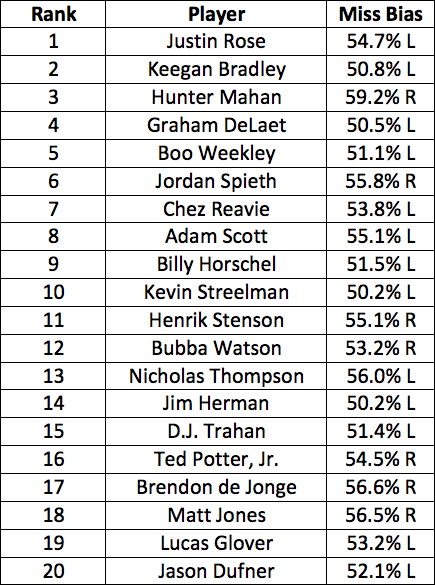
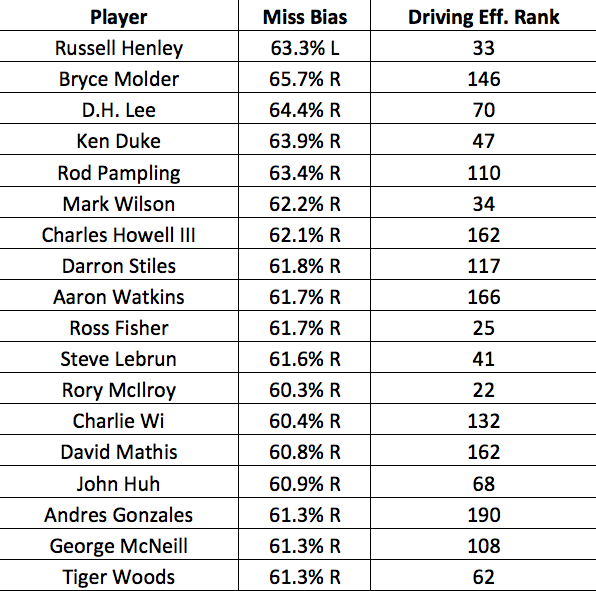
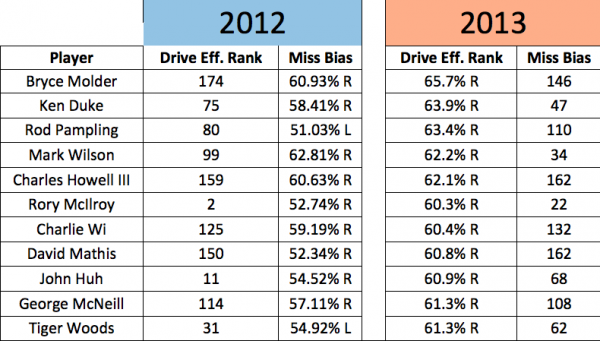


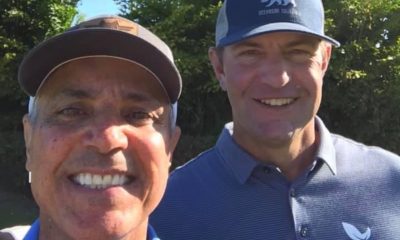









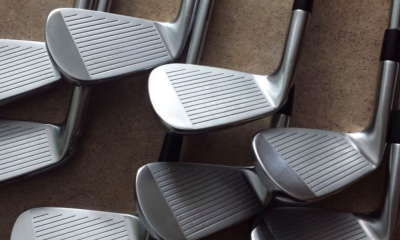













Pingback: Tips in Beating a Pro Golfer – Aymerich Golf Club
TheFightingEdFioris
Sep 4, 2014 at 1:28 pm
Cool article by the way. Always enjoy your writing.
TheFightingEdFioris
Sep 4, 2014 at 1:28 pm
No look into what they actually scored on the hole and/or the actual distance they missed the fairway by? Were Tiger’s driving stats better in 2012 when he missed it left more than right? Apparently… But did the left miss cost him a shot in a few tournaments? Absolutely (see 2012 PGA when Rory missed left off the tee basically zero times)
I am not disagreeing, you’ve clearly done a lot more homework on this than I have. But would you agree Rich that the biggest advantage to feeling that you have a one way miss is mental? To stand on a tee box and know you can swing as hard as you want and not even sniff the OB left, or not worry about blocking it high and right.
Jtriscott
Aug 7, 2013 at 12:06 pm
I think this is pretty simple…
There is usually a side on the hole that is a much better miss (ie, hazard, OB, etc).
For the RH golfer:
If the good miss is RIGHT, I just weaken my grip and make sure I am not going to HOOK the ball.
If the good miss is LEFT, I strengthen my grip and make sure I am not going to SLICE the ball.
It works all the time, 60% of the time!
Geoffrey
Apr 9, 2014 at 12:09 pm
Is there any way to interpret a players extreme left vs right miss tendency to determine if a player’s primary shot is a draw vs a fade?
Mike
Jul 31, 2013 at 9:01 pm
This article could not be more on point! The best players know which direction their ball will curve on less than perfect shots. When they talk about eliminating one side of the course, what they mean is eliminating one direction the ball will curve on their poor shots. And Matteo, as a club fitter you should know that tour players have their own clubs built with exactly this in mind. Nice article.
CT
Jul 31, 2013 at 11:22 am
“What I’ve seen from my tour players is that having a “one-way miss” is actually more about having a “one-way curve.” ”
You should make that the title of the article, and the first sentence summary to set the writing, because this information is great stuff. Because that what it is – it’s all about the favored curve.
Richie Hunt
Jul 31, 2013 at 2:22 pm
Thanks for the kind words. I had a little difficulty coming up with a good title.
Dustin
Jul 30, 2013 at 8:52 pm
The one way miss is a draw or fade. I can miss a fade down the left and a draw down the right. Point is I want a shot that I know will fade or draw.
Steve
Jul 30, 2013 at 5:53 pm
Good article…working with tour players it makes perfect sense. Keep sharing 🙂
Brian
Jul 30, 2013 at 12:09 pm
While the data is interesting, I think the conclusion you are drawing from it is a bit heavy. Just because a player misses in one direction more often off the tee, doesn’t mean they are neccesarily trying to miss in that direction. And, in my opinion, a player, especially a pro, who is truly trying to “miss” in one direction would see something more like 70/30 at the worst, not 60/40. With that said, from the pro golf that I’ve watched in person, most pros are paying no attention to the old addage and just hitting towering bombs right down the pipe. With the low spin driver and ball technology available, and the caliber of swings, it just seems to be the norm. Perhaps the approach data is more rellevant?
Also, the math behind what you consider a “myth” is that if you can eliminate one side of the course, your bigger misses are less threatening. Think about it. If you have a 20 yard wide fairway, and you know you won’t miss left, you can aim at the left side of the fairway and afford a 0-20 yard miss to the right side of the fairway. If you have no bias, then you aim down the middle, and you can afford a 0-10 yard miss in either direction.
And let’s be honest, nobody, not even the pros, can truly eliminate one side of the course. If a RH golfer has a trusty fade, at some point they are going to double cross and yank one left. That’s the true definition of a miss, otherwise it’s just a shot shape.
Richie Hunt
Jul 31, 2013 at 9:08 am
Brian,
I agree with what you are saying about the player ‘not trying to miss in that direction.’ I think those with a larger miss bias are likely struggling with a shot that does not prevent them from missing towards that bias.
Dixie Flatline
Jul 30, 2013 at 9:58 am
I think the author is taking the phrase “one way miss” and “taking one side of the golf course out of play” too literally. Those phrases are used in a discussion of ball flight off the tee, not where the ball actually lands.
Richie Hunt
Jul 30, 2013 at 10:05 am
Perhaps that is the case and I can respect your opinion on that. I know that when discussing this with some golfers, even some of my Tour clients, they think of it in very literal terms.
The main point I was trying to convey is that the miss biases on Tour are not as pronounced as some people tend to think it is and those with more pronounced miss biases tend to not hit it as well off the tee.
steff
Jul 30, 2013 at 9:23 am
A one way miss has nothing to do with the fairway! It depends on were you aim and the knowlage the if you miss it wont go left or right.
Example: You have OB left but you open up the hole the more left you aim.
This is were a “one way miss” comes in handy. You can aim close to the OB and you feel confident that if you hit it good it will go were you aim. But a miss will never go OB! A bad shot will allways go to the right and not OB.
Jokke
Jul 30, 2013 at 3:38 am
I totally agree with the above comments that the data used in this article has nothing to do with one-way misses. None whatsoever.
stephenf
Jul 30, 2013 at 3:33 am
It may be that the secondary goal of “taking one side out of play” isn’t particularly valid, but the primary reason to establish a go-to consistent curve is simply that you’ll have the whole width of a fairway to miss (or something close to it) rather than only half the fairway (as happens if you don’t know which way you’re likely to curve it, and you have to hit it down the middle and hope for the best).
Mateo
Jul 30, 2013 at 1:33 am
Wow. utterly pointless article.
This dude must be a 25 handicap.
Eliminating a side of the golf course has nothing to do with what side of the fairway you miss. It has to do with the 15 of variables he obviously will never understand.
As a teacher, a club fitter, a golf nut, and a scratch player with years of tourney experience……………. I advise everyone to disregard this article.
Richie Hunt
Jul 30, 2013 at 10:01 am
I fully stand behind what I have written.
The article is discussing about missing either left or right. The ‘one way miss’ is often described as if you miss, you miss one direction or the other (left or right).
As we can see, once the ratio is greater than 55/45 the player tends to become less effective off the tee. Particularly as the ratio gets to 60/40 or even a greater discrepancy.
I even stated in this very article that there is no difference in somebody who tends to miss left versus misses right. It’s the size of the ratio that matters more.
Why?
I know the obvious variables that can come into play with the way a hole is designed. But the *point* that has been missed is that in general, Tour players do not have very pronounced miss biases and the ones that do; generally do not drive the ball as well.
And I do not think it’s fair to assume that I’m a 25 handicapper just like it would not be fair for me to assume that you are a poor instructor because you were unable to comprehend my obvious points.
Nick
Jul 30, 2013 at 4:35 pm
Haha, you must be trolling dude. Either that or you like to run your mouth about people you don’t know.
Nick
Jul 30, 2013 at 4:36 pm
My previous comment was directed at Mateo if that wasn’t clear.
Mat
Jul 29, 2013 at 7:03 pm
Very low correlation here.
Imagine a hole that goes water-rough-fw-rough. Player aims centre-right to ensure that only a left miss would be a strong left miss to get wet. Whether the player hits the fairway or not is almost irrelevant; it’s that the ball isn’t wet.
If you’re not sure why, flip the hole; rough-fw-rough-water. It’s effectively even.
If you want to study misses like this, correlate the number of penalising hazards a player hits vs their average fairways hit. In other words, do they put it in the water more because they ignore the one-way miss. Or, an even stronger cause-effect is to see how often players miss to the opposite side of water in the rough.
Bryce Molder, at 66%, simply means he misses right more often when he misses at a rate of not quite 1 in 3. Assuming he hits 8 of 14 in a round, that means that he’s going to miss 4 right, 2 left. Just one shot per round would flip that, and he’s the worst there is.
I’m not buying this one as-is.
Richie Hunt
Jul 30, 2013 at 10:10 am
Mat,
I think you’re missing the point that players with more pronounced miss biases tend to be less effective off the tee. I also point out players like Tiger, Rory, John Huh and Rod Pampling as players whose miss biases became much more pronounced this year and they are now less effective off the tee.
My Driving Effectiveness algorithm takes into consideration shots that go in hazards (i.e. Missed Fairway – Other %) and fairway bunkers hit % as well as Avg. Distance from Edge of Fairway. I could certainly look at the correlation just between miss bias and Missed Fairway Other and fairway bunker %, but the big picture here is that when it comes to all of the main factors that relate to effectiveness off the tee; the bigger miss biases tend to make golfers less effective off the tee.
Brian
Jul 29, 2013 at 5:40 pm
I think you missed the point of having a one way miss. It’s not so much which side you miss it on, it’s that is usually the same side that you miss it on.
The point is to always miss right, or always miss left. The side doesn’t matter, just that you aren’t missing left half the time and right half the time. These stats have absolutely nothing to do with the point of a one way miss.
Nick
Jul 30, 2013 at 4:29 pm
Did you read his article? He’s saying that while people say exactly what you said, a statistical review of the best drivers shows most have no more than a five percent favoritism towards missing on one side as opposed to the the other, which many who have a much stronger statistical favoratism for one side (i.e. the guys who seem to be the best able to take one side or the other out of play) are not ranking high on driving effectiveness.
I think the issue is that a one sided driver of the ball will simply accrue less penalties, not necessarily find the fairway the best. You can find more fairways but I’ll take multiple shots out of the rough over a rinsed tee shot or god forbid OB or LB and a retee. Obviously the goal would be to find the fairway, but you can drastically improve your scoring by cutting out penalties if your game features a penality drive or two a round. You could esily be shaving upwards of two – four strokes on eliminating two bad swings that find water and force a drop way back or land OB.
Andy
Aug 8, 2013 at 7:57 pm
You didn’t even read the article dude.
Jeff
Jul 29, 2013 at 5:21 pm
on most golf holes, there is a side that is a worse miss than others. i think in general you see that professional golfers play the odds more than anything else. if there is OB left and lateral hazard right, a right miss is better, but that could just as easily be switched. therefore, having a “one side out” that ignores the particular hole seems worse to me than trying to hit a shot for the hole. i play (and i think most pros play) to a spot that is safe and then work the ball away from the worst trouble. whether it’s right or left, stay away from the worst trouble.